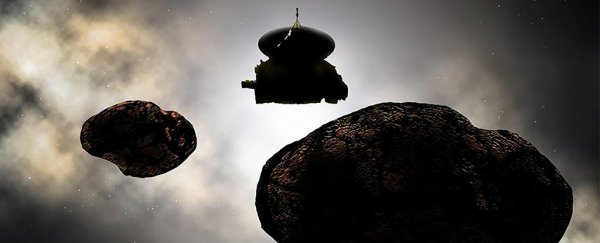There's a small, icy object floating at the outer edge of our Solar System, in the messy Kuiper belt. Or it could be two objects, astronomers are not sure.
But NASA is on track to find out more, as that object has been chosen as the next flyby target for the New Horizons spacecraft - the same probe that gave us incredible photos of Pluto in 2015. And now they want your help to give that target a catchy name.
Currently, the enigmatic Kuiper belt object is designated 2014 MU69, but that's just the provisional string of letters and numbers any newly discovered object gets.
"Yes, we're going to give 2014 MU69 a real name, rather than just the "license plate" designator it has now," New Horizons' principal investigator Alan Stern wrote in a blog post earlier this year.
"The details of how we'll name it are still being worked out, but NASA announced a few weeks back that it will involve a public naming contest."
And now, folks, our time to shine has arrived.
NASA has finally extended an invitation for people to submit their ideas for a name, although they note this is not going to be the officially-official name just yet, but rather a nickname to be used until the flyby happens.
The team at New Horizons already have a bunch of ideas prepared, which now form the basis of the naming campaign, and anyone can already vote for those.
Amongst current choices put forward by the team are Z'ha'dum - a fictional planet from the TV series Babylon 5; Camalor - a fictional city actually located in the Kuiper belt according to Robert L. Forward's novel Camelot 30K; and Mjölnir - the name of Norse thunder god Thor's epic hammer.
One of the most interesting aspects of MU69 is that we're not even sure whether the object is one body or two - telescope observations have hinted it could actually be two similarly-sized bodies either in close mutual orbit, or even stuck together.
"It's a good idea to propose two or more names that go together," New Horizons team remarks on the naming campaign website.
"If the two bodies are touching, a 'contact binary', then we will only need one name. However, if they are separated by empty space, we will need two names."
One of the team suggestions - and currently in the vote tally lead as of writing - is a series of nut-themed names such as Peanut, Almond, or Cashew, depending on what nut shape the possible contact binary might look like.
Now, as opposed to a notorious ship-naming campaign from last year, the nominations for Spacerock McSpaceface MU69's nickname are not a free-for-all, as the team reserves the right to only add a suggestion to the ballot if they like it, and to override the final results of the vote tally.
The nomination guidelines are pretty broad, though - although no political, religious, or commercial suggestions are going to be accepted.
"We are particularly interested in nicknames that are appropriate for the first exploration of a cold, distant, ancient world at the outer frontier of the solar system," the team states. And people have until 1 December 2017 to add their contribution.
The planned flyby will take place on New Year's Day 2019, and it's going to be yet another historical milestone for the New Horizons spacecraft and space exploration alike.
"The spacecraft is about to set the record for visiting the most remote world ever explored by humankind," NASA states on the naming campaign website.
As for an officially-official name, the Kuiper belt object is only getting that once the flyby is complete.
"After the flyby, once we know a lot more about this intriguing world, we and NASA will work with the International Astronomical Union (IAU) to assign a formal name to MU69," says astronomer Mark Showalter from the New Horizons science team.
As Kuiper belt objects are often given names inspired by creation myths from around the world, who knows what the final designation will end up being - that's up to the IAU.
But if it's catchy and appropriate, it could be your idea for a nickname that will go down in space exploration history.
